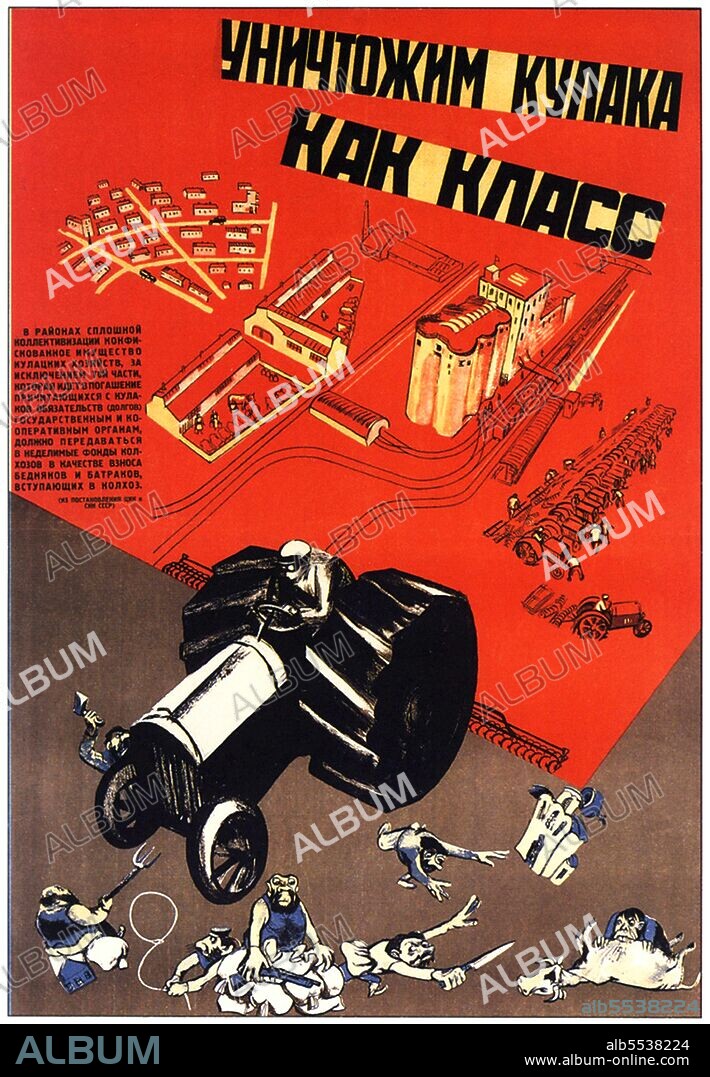alb5538224
Russia / Ukraine: Soviet propaganda poster 'Annihilate Kulaks as a Class', c. 1930

|
Añadir a otro lightbox |
|
Añadir a otro lightbox |



¿Ya tienes cuenta? Iniciar sesión
¿No tienes cuenta? Regístrate
Compra esta imagen.
Selecciona el uso:

Título:
Russia / Ukraine: Soviet propaganda poster 'Annihilate Kulaks as a Class', c. 1930
Descripción:
Traducción automática: Los kulaks eran una categoría de agricultores relativamente ricos en el último Imperio ruso, la Rusia soviética y los inicios de la Unión Soviética. La palabra kulak originalmente se refería a los agricultores independientes del Imperio Ruso que surgieron del campesinado y se hicieron ricos después de la reforma de Stolypin, que comenzó en 1906. La etiqueta de kulak se amplió en 1918 para incluir a cualquier campesino que se resistiera a entregar su grano a los destacamentos. de Moscú. Según la teoría política del marxismo-leninismo de principios del siglo XX, los kulaks eran enemigos de clase de los campesinos más pobres. Vladimir Ilich Lenin los describió como "chupasangres, vampiros, saqueadores del pueblo y especuladores que engordan con el hambre". El marxismo-leninismo había pretendido una revolución para liberar a los campesinos pobres y a los trabajadores agrícolas junto con el proletariado. Además, la economía planificada del bolchevismo soviético requirió la colectivización de granjas y tierras para permitir la industrialización o la conversión a la producción agrícola a gran escala. En la práctica, los funcionarios del gobierno se apoderaron violentamente de las granjas de los kulaks y asesinaron a los resistentes; otros fueron deportados a campos de trabajo
Kulaks were a category of relatively affluent farmers in the later Russian Empire, Soviet Russia, and early Soviet Union. The word kulak originally referred to independent farmers in the Russian Empire who emerged from the peasantry and became wealthy following the Stolypin reform, which began in 1906. The label of kulak was broadened in 1918 to include any peasant who resisted handing over their grain to detachments from Moscow. According to the political theory of Marxism–Leninism of the early 20th century, the kulaks were class enemies of the poorer peasants. Vladimir Ilyich Lenin described them as 'bloodsuckers, vampires, plunderers of the people and profiteers, who fatten on famine'. Marxism–Leninism had intended a revolution to liberate poor peasants and farm laborers alongside the proletariat. In addition, the planned economy of Soviet Bolshevism required the collectivisation of farms and land to allow industrialisation or conversion to large-scale agricultural production. In practice, government officials violently seized kulak farms and murdered resisters; others were deported to labor camps.
Crédito:
Album / Pictures From History/Universal Images Group
Autorizaciones:
Modelo: No - Propiedad: No
¿Preguntas relacionadas con los derechos?
¿Preguntas relacionadas con los derechos?
Tamaño imagen:
3500 x 5050 px | 50.6 MB
Tamaño impresión:
29.6 x 42.8 cm | 11.7 x 16.8 in (300 dpi)
Palabras clave:
ART • ARTE • ARTES • CARTEL • CARTELERÍA • COLECTIVIZACION • COMUNISMO • HISTORIA • HISTORICO • INANICION • POSTER • PROPAGANDA • RUSA • RUSIA • RUSO • RUSOS • STALIN • UCRANIA • UCRANIANO • UNION DE REPUBLICAS SOCIALISTAS SOVIETICAS • UNION SOVIETICA • URSS
 Pinterest
Pinterest Twitter
Twitter Facebook
Facebook Copiar enlace
Copiar enlace Email
Email
